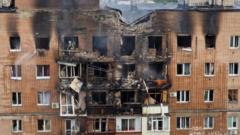This incident highlights the unanticipated consequences of warfare on critical infrastructure, prompting a reevaluation of security measures for sites of historical and environmental significance.
Drone Strike Raises Alarm Over Chernobyl's Security and Integrity

Drone Strike Raises Alarm Over Chernobyl's Security and Integrity
A recent drone attack on the Chernobyl nuclear power plant has revealed vulnerabilities in its protective shell, initially designed to withstand major natural disasters.
A Ukrainian air defense unit captured footage of damage inflicted by a drone strike on the Chernobyl nuclear power plant, highlighting the facility's vulnerability amidst ongoing conflicts. This drone attack, linked to Russian forces, has punctured the protective steel shield that encases the site of the catastrophic 1986 nuclear disaster.
Engineered to withstand extreme conditions for a century, the massive shield—an engineering marvel weighing nearly 40,000 tons and measuring the height of a football field—was primarily designed to endure natural disasters, not acts of war. Eric Schmieman, a 78-year-old retired civil engineer and senior adviser for the construction of this shield, expressed concerns about this unforeseen threat, noting that such acts were never accounted for in their rigorous safety analyses.
On February 14, Ukrainians reported that a Shahed 136 drone, which likely costs about $20,000, targeted the protective structure, allegedly under orders from Russia, a claim that the Kremlin has denied. The resulting strike created a breach in the steel shell, leading to a significant emergency response. Despite extinguishing the initial fire promptly, smoldering debris within the insulation persisted for nearly three weeks, raising fears of further damage.
Artem Siryi, head of operations for the New Safe Confinement, noted that emergency workers had to drill into the outer shield to locate and extinguish lingering flames, a risky move considering the structure's design to remain dry in order to prevent rust and degradation. This incident underscores the fragility of the world’s guarding mechanisms against nuclear threats and showcases the broader implications of war on critical infrastructures worldwide.























